Boost Team Success with Top Sales Training Tools
Did you know that companies with effective sales training see a 29% higher win rate compared to those without? Yet, many businesses still struggle with the consequences of insufficiently trained sales teams, which can lead to lost revenue, disengaged employees, and high turnover rates.
However, to overcome these challenges and drive sustainable growth, businesses must invest in robust sales training tools that can equip their team with the right skills to drive better business outcomes. These innovative solutions empower teams to sharpen their skills, stay agile in a changing market, and ultimately, close more deals.
This blog provides in-depth coverage of why such tools are essential, the need for these tools in the market and the different types available to choose from. Let’s dive into the exciting world of sales training tools and transform how your team sells!
What are Sales Training Tools?
Sales training tools are software applications or platforms that equip sales teams with vital skills and knowledge. These tools offer a combination of online courses, real-world scenario simulations, and interactive modules that help sales representatives improve their product knowledge, enhance sales techniques, and build successful selling habits. The content can range from product specifications to sales scripts, customer handling tips, and best practices.
Sales training tools serve as an efficient way to streamline the onboarding process for new hires and provide continuous learning opportunities for seasoned professionals.
What is the Need for Sales Training Tools?
Sales training tools play a crucial role in addressing key challenges and unlocking the full potential of sales teams. These tools are essential for enhancing productivity, improving skill retention, and boosting sales numbers as well as team morale. Let's discuss these benefits in detail.
Enhanced Productivity: These tools automate many repetitive tasks, such as scheduling and follow-ups. This frees up valuable time for your sales reps to focus on high-value activities like prospecting and closing deals.
Improved Skill Retention: Effective sales training isn’t just about learning new skills but retaining them over time. Regular, bite-sized training modules keep your team up-to-date with the latest sales techniques and industry trends. This continuous learning fosters skill retention and prevents knowledge gaps.
Higher Sales Numbers: Sales training tools can track your team's performance and identify areas for improvement. By analyzing these insights, you can make data-driven decisions to optimize your sales strategy.
Stronger Team Morale: Well-trained salespeople are more confident in their abilities. This confidence translates to better performance and higher morale. By investing in your team's training and development, you show your commitment to their professional growth.
Types of Sales Training Tools
Several types of sales training tools are available based on your sales team's needs and the specific areas you would like to focus on. Some of these include Learning Management Systems (LMS), Sales Customer Relationship Management (CRM) Software, Authoring Tools, Sales Enablement Tools, Workflow Tools, and Mobile Apps for on-the-go training. These tools aim at different critical aspects of sales training and are versatile in their applications. Here's how:
Learning Management Systems (LMS)
An LMS is a software application that administers, documents, tracks, reports, and delivers educational courses or training programs. It serves as the foundation of any effective sales training strategy.
Key benefits of using an LMS for sales training:
Centralized Learning: An LMS centralizes all your training content, making it easily accessible to your sales reps from any location.
Structured Learning Paths: Design custom learning paths for your team with a step-by-step progression. It ensures proper learning flow and comprehensive coverage of all topics.
Tracking and Reporting: LMS offers robust tracking and reporting features, providing insights into the learning progress of the team and the effectiveness of your training program.
Integration with other Systems: LMS typically integrates well with CRM systems, enabling you to transfer learning data for better analysis easily.
Here are some examples of Learning Management Systems (LMS) commonly used for sales training.
Talent LMS is an intuitive and scalable platform designed for small to medium-sized businesses to deliver effective sales training. It simplifies setup, offers gamification to boost engagement, and allows customization to align with business goals. With its user-friendly interface and robust reporting features, TalentLMS enables sales teams to upskill quickly and stay productive, making it an ideal choice for growing organizations.
Adobe Captivate Prime is perfect for organizations seeking to create visually engaging and interactive sales training programs. It supports video-based learning, simulations, and seamless integration with Adobe Creative Cloud for content creation. With robust tracking and reporting features, it ensures measurable progress while delivering immersive training experiences, making it a top choice for enhancing sales team performance.
Sales Customer Relationship Management (CRM) Software
Sales CRM Software is a tool designed to help businesses manage their relationships and interactions with existing and potential customers. Besides being an essential tool for managing leads and tracking customer behavior, CRM software can also be used as a considerable part of sales training tools.
Here are a few benefits of using CRM software for sales training:
Real-world Context: Using CRM software for training adds a layer of real-world context to your team. Reps can practice their sales skills and techniques on real leads within the CRM.
Improves CRM Adoption: Incorporating CRM software in your training program can lead to better CRM adoption rates among your sales reps since they learn how to derive value from it.
Automated Training: Some CRMs come with automated training features that guide new hires through different modules while keeping track of their progression.
Some examples of Sales CRM Software include:
HubSpot CRM is a versatile tool designed for businesses to manage customer relationships and streamline sales processes. Ideal for small to medium-sized teams, it offers intuitive lead tracking, real-time insights, and seamless integration with marketing tools. With features like automated workflows and a user-friendly dashboard, HubSpot CRM enhances productivity and empowers teams to close deals faster.
Salesforce is a powerful CRM platform tailored for businesses of all sizes to manage customer relationships, automate sales processes, and gain actionable insights. Known for its scalability and customization, it integrates seamlessly with various tools and provides advanced analytics. With AI-powered features like Einstein, Salesforce enhances decision-making, boosts productivity, and empowers sales teams to close deals effectively.
Authoring Tools (for Product Walkthroughs)
Authoring Tools are used to create digital content, such as product walkthroughs, tutorials, and online courses. These tools usually offer capabilities such as screen recording, voiceover recording, and interactive features for creating product knowledge training modules.
A sophisticated authoring tool can often export the content in SCORM or xAPI formats, making them easy to integrate with most Learning Management Systems (LMS).
Moreover, authoring tools equip your sales team with skills mastery and situational acumen. They craft sales narratives grounded in real-world scenarios, enabling your team to offer relatable solutions to customers - driving customer engagement and raising the frequency of successful deals.
Book a live demo to experience how SmartCue's interactive product walkthroughs can transform your product training.
Here are some examples of commonly used Authoring Tools.
iSpring Suite is an intuitive authoring tool designed to create interactive product walkthroughs, eLearning courses, and quizzes. It offers easy-to-use features like screen recording, voiceover integration, and drag-and-drop interactivity. With SCORM and xAPI compatibility, iSpring Suite seamlessly integrates into most LMS platforms, empowering teams to deliver engaging, high-quality training content that enhances skills and improves learning outcomes.
WalkMe is a leading digital adoption platform designed to create interactive product walkthroughs and guide users through complex workflows. It helps businesses onboard employees and customers by offering step-by-step, in-app guidance. With features like analytics, real-time support, and easy integration with existing systems, WalkMe enhances user engagement, boosts productivity, and accelerates the adoption of new tools and processes.
Sales Enablement Tools
Sale Enablement Tools aid in providing the sales team with useful resources such as content, tools, knowledge, and information to sell products effectively. These tools also play a significant role in creating and managing a centralized content library, aligning sales and marketing efforts, and offering valuable insights and analytics.
Key benefits of sales enablement tools include:
Centralized Content Hub: Sales enablement tools help to organize all marketing collateral and content in one place, making it easily accessible to your sales team.
Content Performance Analysis: These tools have robust analytics capabilities, allowing you to understand what type of content resonates most with your clients.
Effortless Communication: Sales enablement tools also provide a unified channel for direct communication between sales and marketing teams, ensuring everyone is on the same page.
Sales Process Optimization: By providing relevant content and insights at each stage of the sales process, these tools can significantly enhance the sales journey.
Examples of Sales Enablement platforms are:
Brainshark is a sales enablement platform designed to improve sales team performance through training, coaching, and content management. It offers features like video-based training, content creation, and performance analytics. Brainshark helps sales teams stay aligned with messaging and enhances their skills, empowering them to engage prospects effectively and close more deals.
DocSend is a document-sharing platform that enables sales teams to securely share and track sales materials with clients. It provides real-time analytics, allowing teams to monitor engagement and adjust follow-ups accordingly. With its secure document tracking and version control, DocSend helps ensure that sales teams present the right materials at the right time to increase conversion rates.
Workflow Tools
Streamlining workflow and daily tasks optimize your sales team's performance; this is precisely what Workflow Tools accomplish. These tools facilitate seamless project management, task delegation, time tracking, and document management. They help create a transparent work environment, keep the team organized, and enhance productivity.
It reduces the overall time spent on task administration and allows your sales representatives to focus more on crucial things like mastering key sales skills and closing deals.
Some examples of Workflow tools include:
ClickUp is an all-in-one project management tool that streamlines workflows by enabling task delegation, time tracking, and document management. It offers customizable features like views, templates, and automated workflows, enhancing team collaboration and efficiency. ClickUp helps sales teams stay organized, prioritize tasks, and improve productivity, ultimately enabling them to focus on closing deals and achieving sales goals.
Trello is a visual collaboration tool that simplifies project management and task organization for sales teams. Using boards, lists, and cards provides a clear overview of tasks and deadlines. Trello helps teams prioritize and track progress, ensuring that sales representatives stay focused on key activities. Its simplicity and ease of use make it ideal for improving team productivity and collaboration.
Mobile Apps for On-the-Go Training
Mobile Apps compatible with sales training tools allow your sales team to have access to training resources anytime, anywhere. They are particularly effective for teams that frequently work remotely or travel for sales meetings.
Here's how mobile apps can be helpful:
Continuous Learning: Mobile apps allow your team to learn continually, regardless of location or time constraints.
Real-time Access to Information: Sales reps can access relevant information in real time before or during customer interactions, improving client communication.
Improved Engagement: Mobile apps often have dedicated features optimized for user interaction and convenience, resulting in higher user engagement.
Increased Flexibility: Mobile apps offer your reps the flexibility to learn at their own pace, at a time and place that suits them best.
Here are examples of mobile apps compatible with sales training tools:
Showpad is a sales enablement platform that provides a mobile-friendly solution for sales teams to access training materials, product content, and sales tools on the go. With its easy-to-use interface, Showpad helps sales representatives stay informed, collaborate effectively, and deliver personalized presentations to clients, ultimately improving engagement, closing rates, and overall sales performance.
Grovo is a microlearning platform designed to enhance sales team training with bite-sized, interactive content. It allows businesses to create customized learning paths that can be accessed on-demand, making it ideal for remote or traveling teams. With its engaging, easy-to-consume modules, Grovo helps sales teams quickly grasp key concepts, improve skills, and stay updated, boosting performance and productivity.
Top 5 Sales Training Tools for 2024
As the technology landscape continues to evolve, companies require robust, adaptable, and future-proof solutions for training their sales reps. Continue reading as we discuss our top five picks for the best sales training tools in 2024. These tools promise comprehensive training solutions with many innovative features custom-built for sales teams.
SmartCue
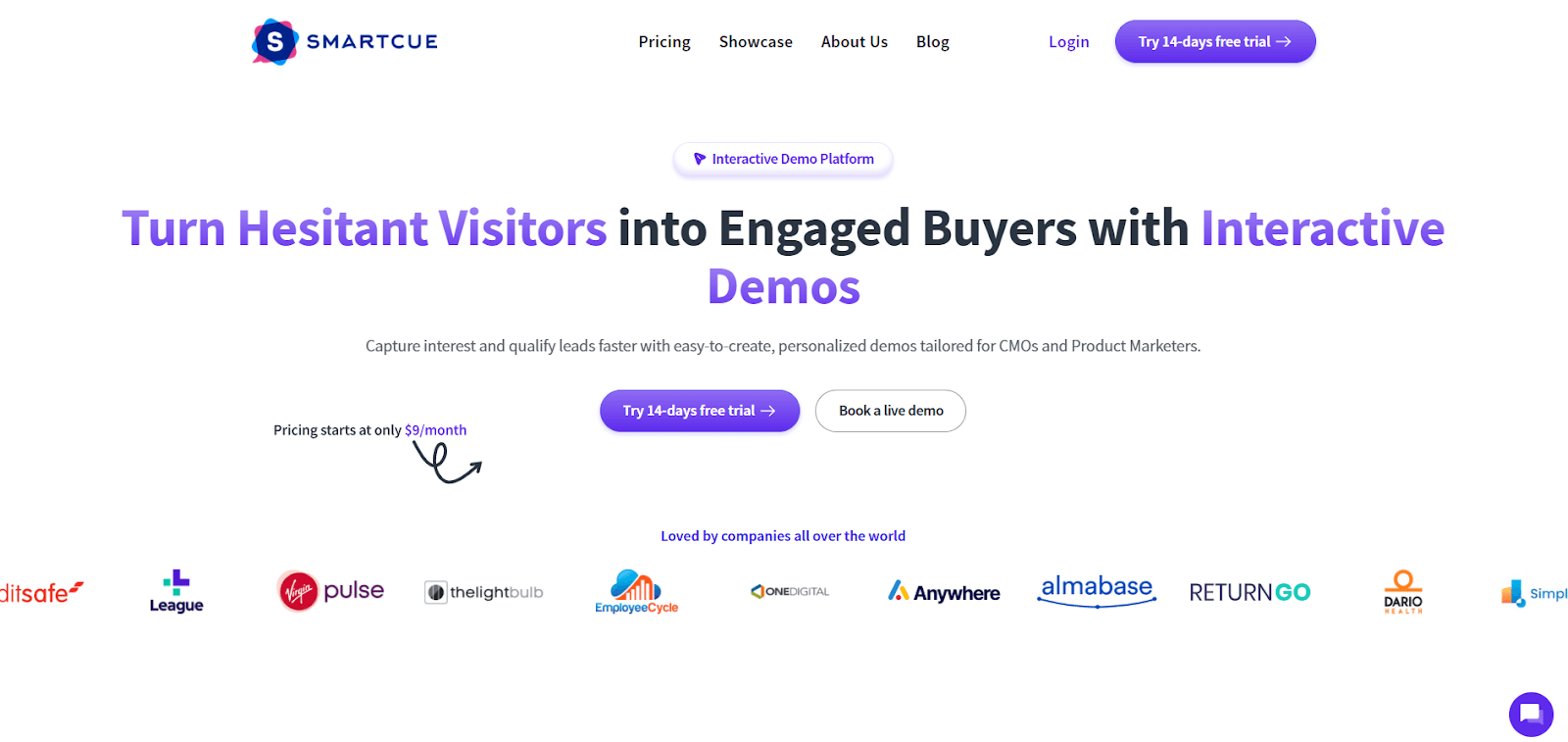
SmartCue is an innovative sales enablement platform designed to empower sales teams with the knowledge and tools they need to succeed. By providing interactive product walkthroughs, SmartCue helps organizations streamline their training processes and boost sales performance.
Key Features of SmartCue:
Interactive Product Walkthroughs: Create engaging and interactive product demos that guide users through key features and benefits.
Customizable Templates: Easily customize templates to match your brand and messaging.
Real-Time Analytics: Track user engagement and performance to identify areas for improvement.
Seamless Integration: Integrate with your existing CRM and sales enablement tools.
Mobile-Friendly Access: Access training materials on any device, anytime, anywhere.
SC Training (formerly EdApp)
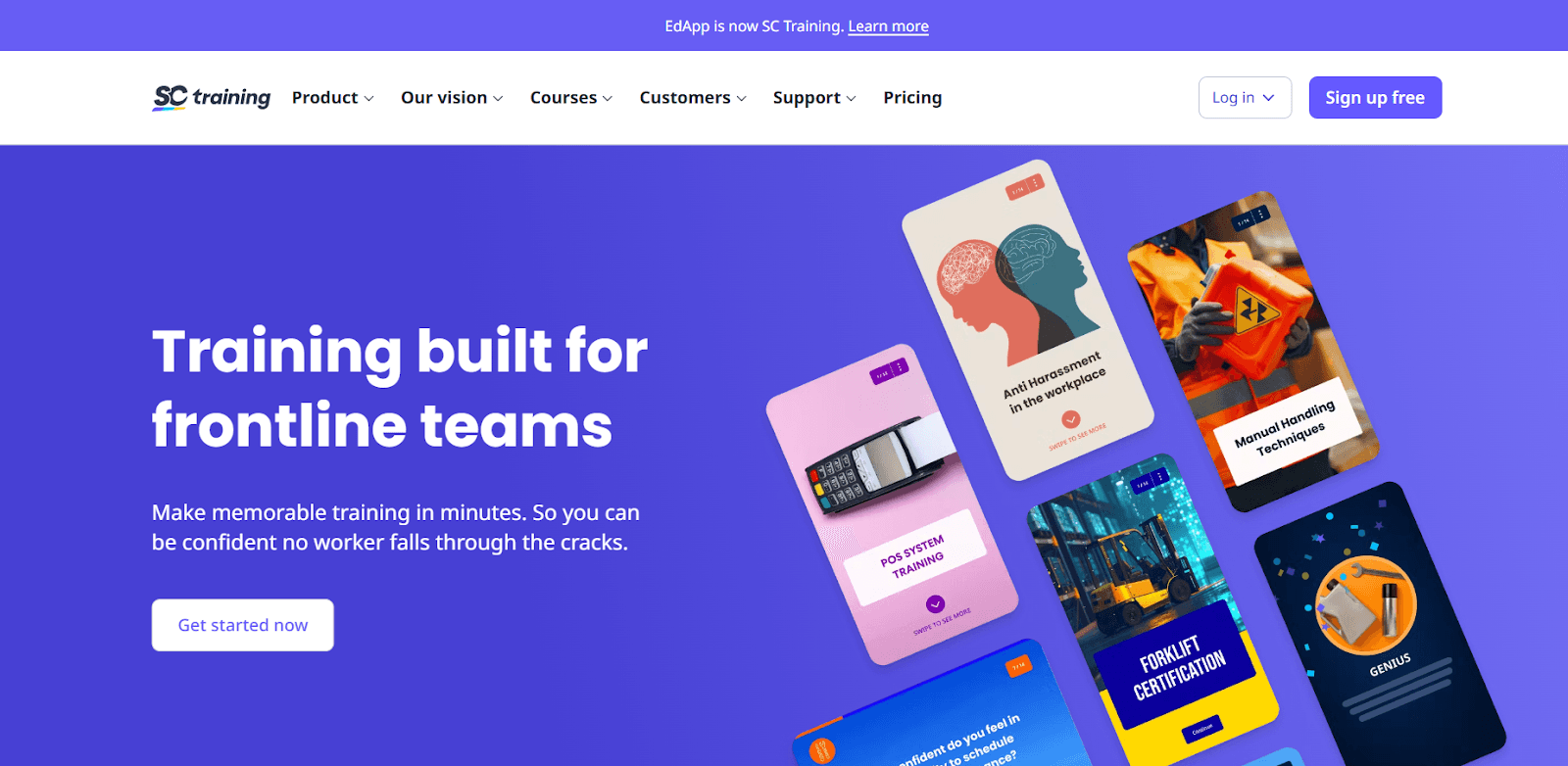
Alt text: SC Training’s landing page
SC Training, formerly known as EdApp, is a leading microlearning platform designed to deliver engaging and effective training experiences. It empowers organizations to create, deliver, and track employee training programs efficiently.
Key Features of SC Training:
Mobile-First Design: Ensures easy access to training materials on any device, anytime, anywhere.
Gamification: Incorporates game-like elements to make learning fun and engaging.
AI-Powered Authoring Tool: Quickly create high-quality training courses with the help of AI.
Performance Tracking: Monitor learner progress and identify areas for improvement.
Certification and Compliance: Issue certificates and track compliance with industry standards.
Social Learning: Foster collaboration and knowledge sharing among learners.
Custom Branding: Tailor the platform to your organization's branding and style.
Mindtickle
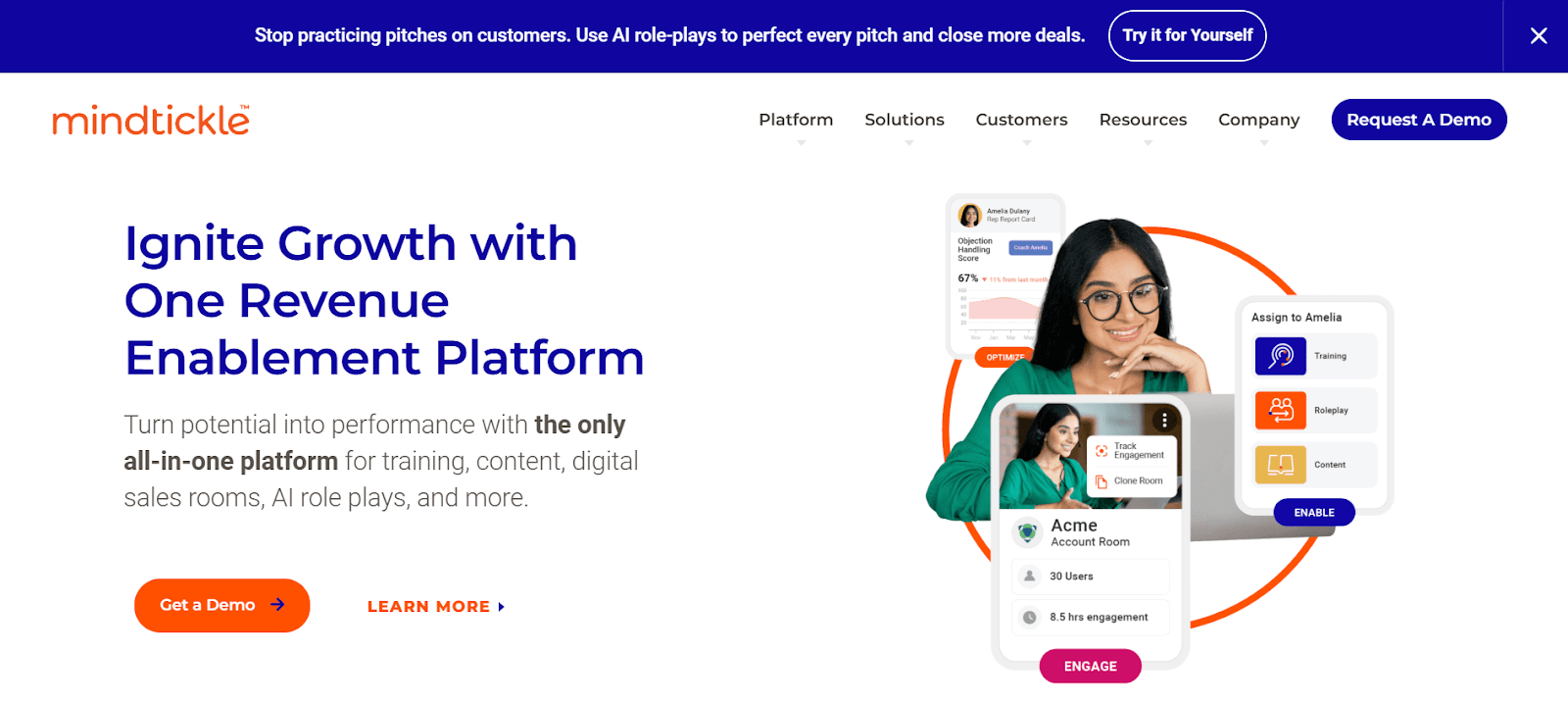
Mindtickle is a robust sales enablement platform designed to equip sales teams with the tools and knowledge they need to succeed. By streamlining sales processes and improving sales performance, Mindtickle helps organizations achieve their revenue goals.
Key Features of Mindtickle:
Content Management: Centralizes and organizes sales and marketing content, making it easily accessible to sales reps.
Training and Enablement: Delivers targeted training programs and coaching to upskill sales teams.
Sales Coaching: Provides real-time coaching and feedback to help reps improve their performance.
Sales Performance Analytics: Tracks key performance indicators (KPIs) and provides insights to optimize sales strategies.
Gamification: Uses gamification elements to motivate and engage sales reps.
AI-Powered Insights: Leverages AI to analyze sales data and identify opportunities for improvement.
CRM Integration: Seamlessly integrates with popular CRM systems to provide a unified view of customer data.
Highspot
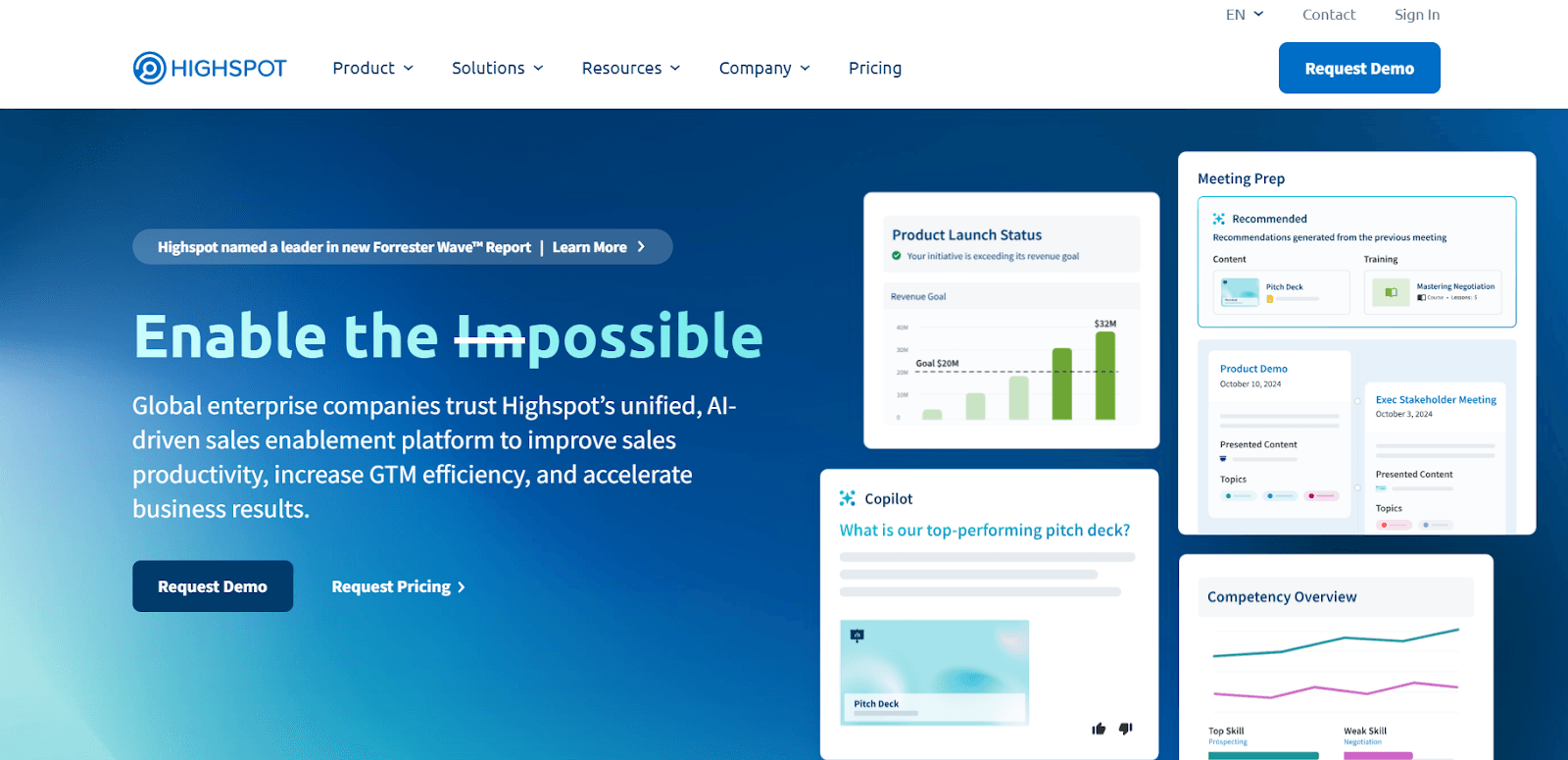
Highspot is a leading sales enablement platform that breaks the conventional mould with its unique sales training platform. It combines training, coaching, content, and analytics for a seamless experience that amplifies your go-to-market strategy. By providing a centralized repository for sales and marketing content, Highspot empowers sales teams to easily access and share the right content with the right people at the right time.
Key Features of Highspot:
Content Management: A centralized platform to store, organize, and version control all sales and marketing content.
Content Search and Discovery: Advanced search capabilities to find the right content quickly, including AI-powered recommendations.
Content Personalization: Tailor content to specific audiences and sales situations.
Sales Enablement: Provide sales reps with the tools and training they need to succeed.
Sales Analytics: Track sales performance and identify areas for improvement.
CRM Integration: Seamlessly integrates with popular CRM systems to provide a unified view of customer data.
Lessonly by Seismic
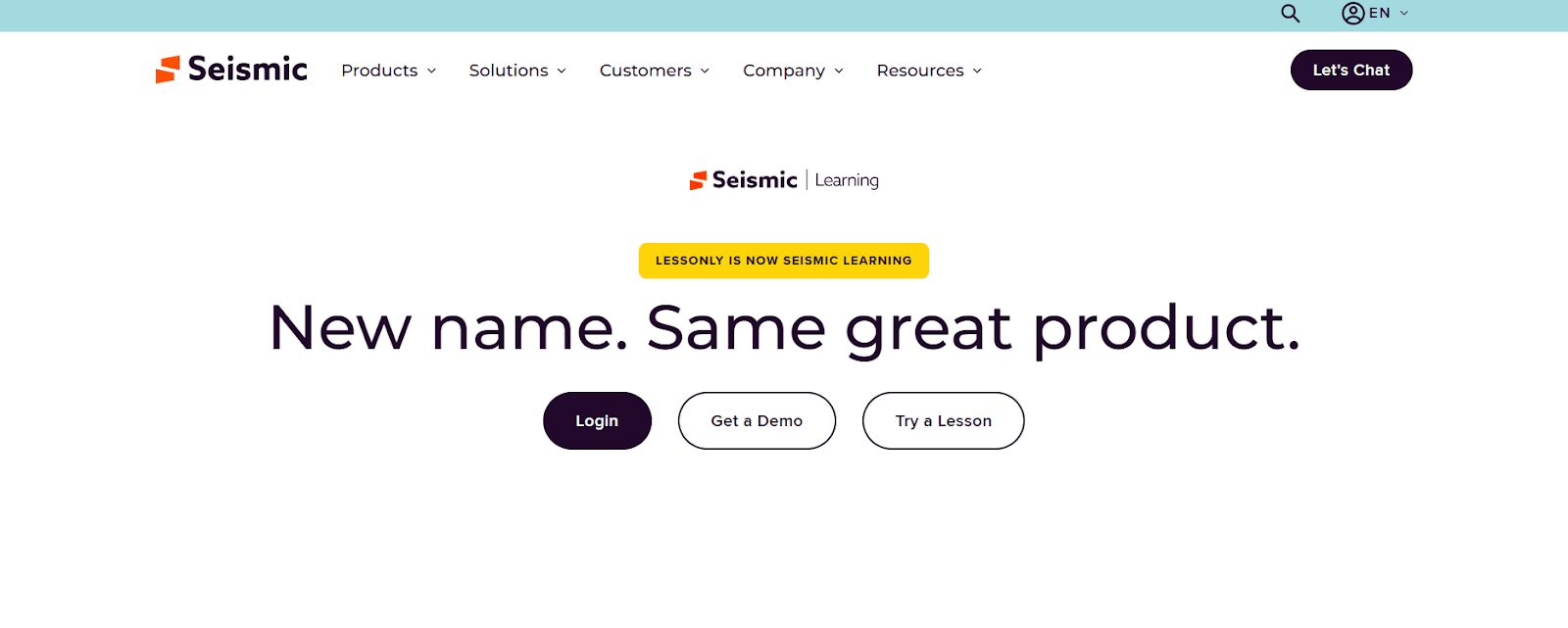
Lessonly, now part of Seismic, is a powerful coaching and learning platform designed to help teams learn, practice, and perform at their best. Its platform uses artificial intelligence and advanced analytics to enhance sales performance, reduce ramp time, and increase conversion rates. It offers a variety of features to help organizations improve employee onboarding, training, and ongoing development.
Key Features of Lessonly by Seismic:
Microlearning: Delivers training content in short, digestible modules to maximize retention.
Interactive Lessons: Creates engaging learning experiences with quizzes, videos, and simulations.
Role-Playing Scenarios: Provides opportunities for learners to practice real-world scenarios and receive feedback.
Coaching and Feedback: Enables managers to provide targeted coaching and feedback to their team members.
Performance Tracking: Monitors learner progress and identifies areas for improvement.
Customizable Learning Paths: Creates tailored learning paths for different roles and skill levels.
Integrations: Seamlessly integrates with other tools and platforms, such as Salesforce and Microsoft Teams.
Here's a table that provides a quick overview of each tool's strengths, weaknesses, and pricing considerations, helping you choose the right fit based on your team size and specific training needs.
Tool | Pricing | Pros | Cons |
SmartCue | - A 14-day free trial - Small Business: $9/ month - Scale Up: $40/month - Enterprise: Custom | - Tailored for product training - Interactive learning modules - Real-time analytics | - May not suit companies needing broader sales enablement features |
SC Training | - Free Plan: Up to 10 learners - Premium: $5/user/month - Enterprise: Custom | - Mobile-first, great for on-the-go training - Gamification features - Easy-to-use interface | - Limited customization for content - Best suited for smaller teams |
Mindtickle | Starts at $10/user/month. Contact them for a detailed pricing plan. | - Robust sales readiness features - Extensive content management - Analytics for tracking progress | - Higher cost for small teams - Can be overwhelming for new users |
Highspot | Custom pricing (based on enterprise needs) | - Excellent content management - Integrates well with other tools (CRM, LMS) - Strong analytics capabilities | - Can be pricey for small to mid-sized companies - Complex interface for beginners |
Lessonly by Seismic | Quotation based pricing | - Simple user interface - Great for onboarding and training - Scalable for teams of all sizes | - Limited advanced customization options - Lack of some advanced analytics features |
How to Leverage SmartCue for Effective Product Training?
Delivering effective product walkthroughs is a common challenge, as many struggle with creating engaging, personalized demos that showcase key features while addressing specific customer needs. If you’re facing this issue, don’t worry—SmartCue is here to help! It simplifies the process, enabling you to create tailored product demos in under six minutes. With SmartCue, you can overcome these challenges and impress clients with professional, seamless demonstrations. Here’s how to get started:
1. Sign Up for Free: Begin your SmartCue journey with a 14-day free trial. It’s quick, easy, and gives you access to all the powerful features.
2. Create Your Showcase: Log in and click "Create Showcase" on your dashboard. Depending on your needs, choose to record your screen or upload existing content.
3. Record Your Demo: Use the SmartCue Chrome extension to input the website or software URL and record each step of your demo. You can pause, stop, or delete sections as needed for a flawless recording.
4. Customize Your Demo: Personalize your showcase by editing headers, adding text overlays, and fine-tuning recorded steps. Use SmartCue’s zoom, pan, and blur features to highlight critical areas for maximum impact.
5. Publish and Share: Once satisfied, click "Publish and Share" to generate a unique link. Share the demo effortlessly with team members, new sales employees, clients, or stakeholders to provide a dynamic, engaging experience.
SmartCue revolutionizes product walkthroughs by making them faster, easier, and more impactful. Sign up today and transform how you showcase your products to close deals confidently!
Final Thoughts
Sales training tools are an indispensable asset for any sales-driven organization looking to boost team success and drive remarkable business results. These platforms offer an efficient, flexible, and personalized approach to learning, showcasing the benefits of sales training by elevating sales performance and productivity.
Whether you choose SmartCue for its AI-powered personalization or any other sales training software, ensure it addresses the specific needs of your sales organization, fosters a culture of continuous learning, and leverages analytics to measure success. By doing so, you can transform your salesforce into a high-performing unit.
So, what are you waiting for? Embrace the potential of sales training tools to unlock growth, enhance productivity, and achieve long-term success for your organization!
Frequently Asked Questions
What are some key features to look for in a sales training tool?
Key features to consider include customizable learning paths, integration capabilities with other systems, mobile learning options, robust analytics and reporting capabilities, performance tracking, a variety of course offerings, and built-in authoring tools for content creation.
How do I choose the right sales training tools for my team?
Evaluate your team's specific needs, preferred learning styles, and the skills you aim to develop. Consider factors like ease of use, personalization capabilities, integrations with existing systems, and post-sales support. Always opt for a demo or a free trial if available before committing.
Are there any free or low-cost sales training tools available?
Yes, platforms like SmartCue offer free trials, allowing prospective users to test out the tool before purchasing. Beyond the trial period, SmartCue’s pricing is competitive, starting at just $9 per user, making it an affordable and value-rich option for businesses of all sizes.
How can I measure the impact of sales training tools on my team's performance?
Take advantage of the robust analytics that most sales training tools offer. They allow you to monitor progress, measure course completion rates and skill improvements, and observe correlations between training completion and increases in sales performance or customer satisfaction, which impacts the overall sales cycle. Such data provides insight into the impact of training on the tool's effectiveness for your team.
Comments
Your comment has been submitted